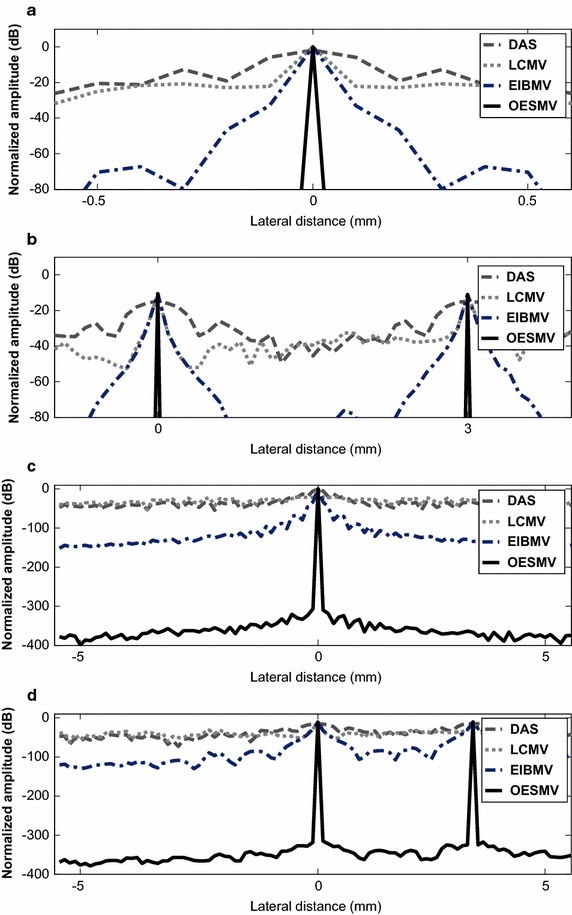Eigenspace-based beamformer using oblique signal subspace projection for ultrasound plane-wave imaging
- PMID: 27881172
- PMCID: PMC5122033
- DOI: 10.1186/s12938-016-0244-4
Eigenspace-based beamformer using oblique signal subspace projection for ultrasound plane-wave imaging
Abstract
Background: The Eigenspace-based beamformers, by orthogonal projection of signal subspace, can remove a large part of the noise, and provide better imaging contrast upon the minimum variance beamformer. However, wrong estimate of signal and noise component may bring dark-spot artifacts and distort the signal intensity. The signal component and noise and interference components are considered uncorrelated in conventional eigenspace-based beamforming methods. In ultrasound imaging, however, signal and noise are highly correlated. Therefore, the oblique projection instead of orthogonal projection should be taken into account in the denoising procedure of eigenspace-based beamforming algorithm.
Methods: In this paper, we propose a novel eigenspace-based beamformer based on the oblique subspace projection that allows for consideration of the signal and noise correlation. Signal-to-interference-pulse-noise ratio and an eigen-decomposing scheme are investigated to propose a new signal and noise subspaces identification. To calculate the beamformer weights, the minimum variance weight vector is projected onto the signal subspace along the noise subspace via an oblique projection matrix.
Results: We have assessed the performance of proposed beamformer by using both simulated software and real data from Verasonics system. The results have exhibited the improved imaging qualities of the proposed beamformer in terms of imaging resolution, speckle preservation, imaging contrast, and dynamic range.
Conclusions: Results have shown that, in ultrasound imaging, oblique projection is more sensible and effective than orthogonal subspace projection. Better signal and speckle preservation could be obtained by oblique projection compare to orthogonal projection. Also shadowing artifacts around the hyperechoic targets have been eliminated. Implementation the new subspace identification has enhanced the imaging resolution of the minimum variance beamformer due to the increasing the signal power in direction of arrival. Also it has offered better sidelobe suppression and a higher dynamic range.
Keywords: Beamforming; Eigenspace-based minimum variance; Oblique projection matrix; Signal subspace; Ultrasound plane-wave imaging.
Figures








Similar articles
-
Eigenspace-based minimum variance beamforming applied to medical ultrasound imaging.IEEE Trans Ultrason Ferroelectr Freq Control. 2010 Nov;57(11):2381-90. doi: 10.1109/TUFFC.2010.1706. IEEE Trans Ultrason Ferroelectr Freq Control. 2010. PMID: 21041127
-
Eigenspace-based minimum variance beamformer combined with Wiener postfilter for medical ultrasound imaging.Ultrasonics. 2012 Dec;52(8):996-1004. doi: 10.1016/j.ultras.2012.07.012. Epub 2012 Aug 8. Ultrasonics. 2012. PMID: 22929478
-
Subarray coherence based postfilter for eigenspace based minimum variance beamformer in ultrasound plane-wave imaging.Ultrasonics. 2016 Feb;65:23-33. doi: 10.1016/j.ultras.2015.10.026. Epub 2015 Nov 10. Ultrasonics. 2016. PMID: 26582600
-
Enhance contrast in PCA based beamformers using smoothing kernel.Biomed Mater Eng. 2015;26 Suppl 1:S1613-21. doi: 10.3233/BME-151460. Biomed Mater Eng. 2015. PMID: 26405926
-
Subspace-based interference removal methods for a multichannel biomagnetic sensor array.J Neural Eng. 2017 Oct;14(5):051001. doi: 10.1088/1741-2552/aa7693. Epub 2017 Aug 18. J Neural Eng. 2017. PMID: 28820740 Free PMC article. Review.
Cited by
-
Eigenspace generalized sidelobe canceller combined with SNR dependent coherence factor for plane wave imaging.Biomed Eng Online. 2018 Aug 13;17(1):109. doi: 10.1186/s12938-018-0541-1. Biomed Eng Online. 2018. PMID: 30103746 Free PMC article.
References
-
- Capon J. High resolution frequency-wavenumber spectrum analysis. Proc IEEE. 1969;57:1408–1418. doi: 10.1109/PROC.1969.7278. - DOI
-
- Sasso M, Cohen-Barcie C. Medical ultrasound imaging using the fully adaptive beamformer. Proc IEEE Int Conf Acoust Speech Signal Process. 2005;2:489–492.
MeSH terms
LinkOut - more resources
Full Text Sources
Other Literature Sources

